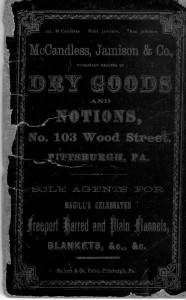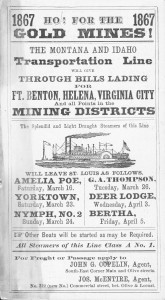In the fall of 2006, I inherited a journal recounting a lively steamboat trip on the upper Missouri River in 1869. The author, Nancy Ann (Poe) Ebert, was my great great grandmother. The trip was one continuous adventure. It is a bit of American History that I shall attempt to bring to life.

Nancy Ann Poe ebert Journal Segment 1 Front
Only two journals, daily written, chronicle that 1869 Missouri River season. The styles could not differ more, yet their comparison provides meaningful insights. In his journal Nelson G Edwards, first clerk of the steamer Henry M Shreve, was objective. Nancy Poe Ebert was observant and emotional. My great great grandmother wrote about loneliness, fear, flowers, disappointment, beauty, and Indians. Indians boarded their steamer for three days causing much anguish. Tracking the two journals, the sidewheeler Henry M Shreve was 8-14 days ahead of the sternwheeler Mollie Ebert at common positions per date along the Missouri.
My transcription of the journal is a rendering with spelling errors and missing punctuation uncorrected. Its length is 59 pages covering 57 grueling days.

Nancy Poe Ebert Journal Segment 2 Front (Anna L and John F Nash Collection
Investigations of the inherited journal and boxes of old photographs and letters led to other stories about the men and women of Georgetown, PA. During the Golden Age of Steamboats which some describe as the period from 1850-1870, Georgetown produced some far famed steamboat captains. Each captain and each steamer has its tale. At a time when railroad transportation meant traveling mostly in upright chairs on unheated soot filled cars that rocked and pitched their way along state imposed “standard” gauge track, steamboats were admired for their luxury, their comfort, their ornamentation — in a word – their style. Steamboats also out performed the rival railroads during that period. More troops and supplies were transported by packets than railroad cars during the Civil War. These Georgetown captains and pilots with their civilian crews were contracted and impressed into service by the Army Quartermaster which led to many tales. The Georgetown captains owned and operated approximately fifty packets during this Golden Age.
Local histories are also numerous, such as the grisly death of a steamboat captain far from home in April 1850, a Paul Revere like ride to warn the area of the danger of attack from Morgan’s Raiders in July 1863, a baseball game with Honus Wagner and his All Stars in August 1924, etc. I am a retailer, not an inventor, of these tales. Vexingly, their stories have been virtually ignored by generations of historians.
Their story was not a story of my choosing, but what could make a better story!



